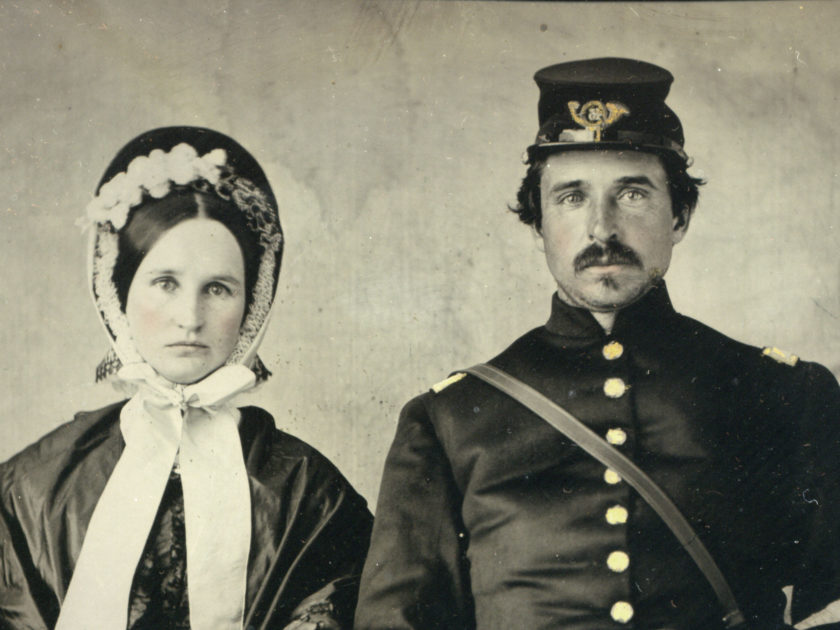Togetherness
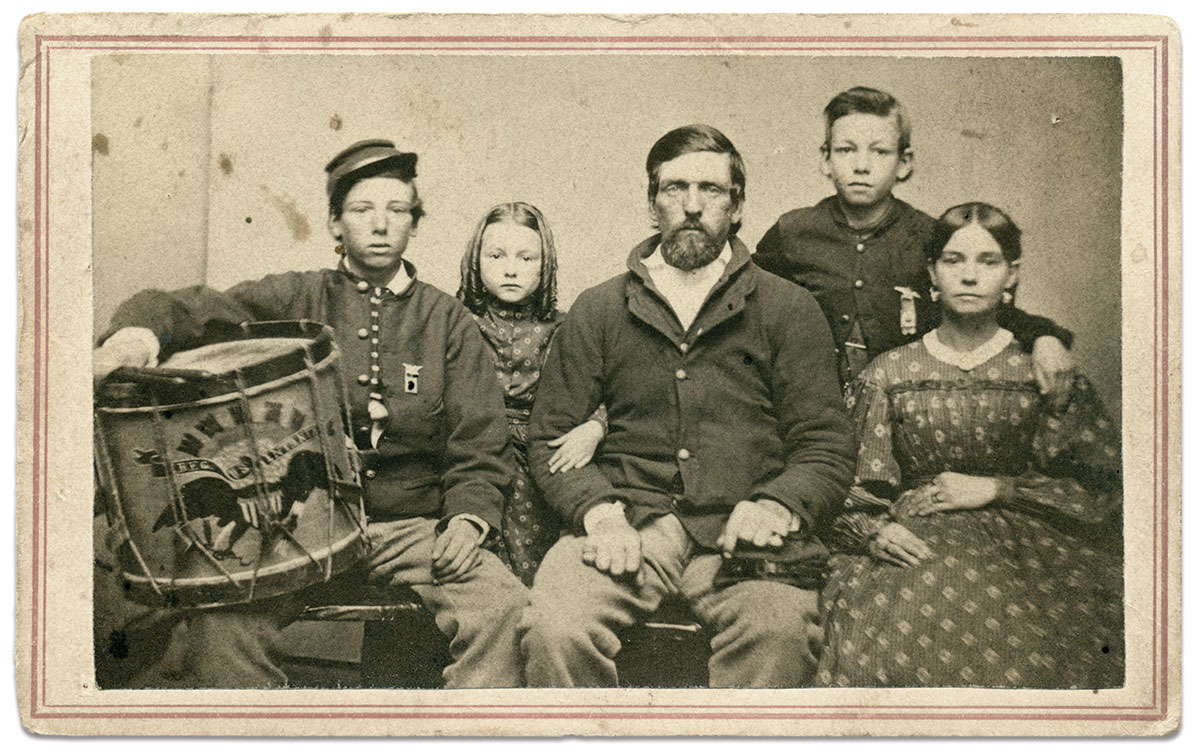
A soldier shares an intimate moment with his family. The eldest son holds a drum upon which is visible “Reg. U.S. Infantry,” while the other boy drapes an arm across his momma’s shoulder. A daughter slips a delicate hand through papa’s arm. The badges worn by the boys are likely patriotic. “John Burton for Wife” is inscribed in the back of the image.
Familial Bonds
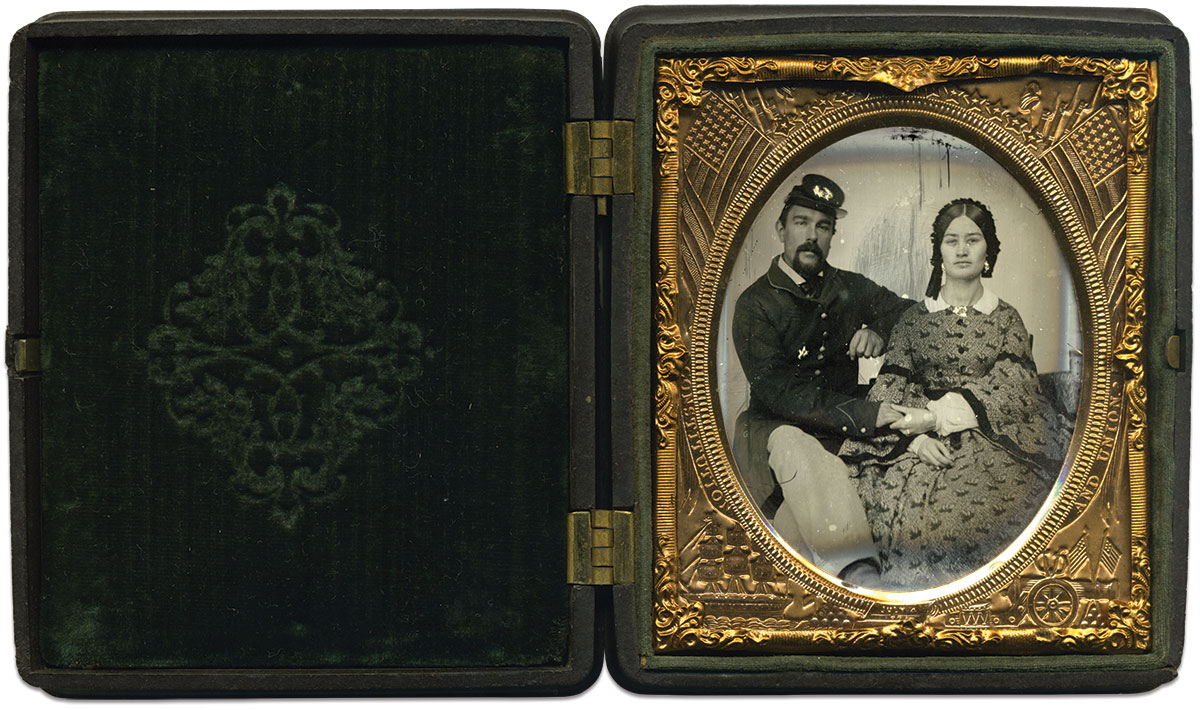
Orra and Mary Wright sat for this portrait in the summer of 1862, after he joined Company E of the 128th New York Infantry. He soon left Mary and a daughter, Maggie, for the South. The 128th spent much of the next year in operations against Port Hudson, Miss., which ended on July 9, 1863, with the surrender of the Confederates. Orra was discharged for disability a few months later. He and Mary would become parents of two more children. Orra died in 1905, and Mary in 1911.
Veterans
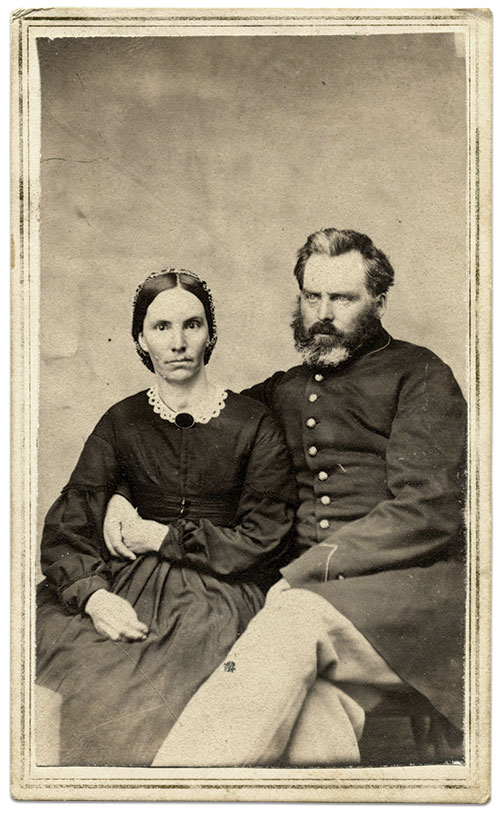
The warmth of this Union couple is magnified by their embrace and handholding.
Friends or Family?

At first glance, Capt. Charles T. Golding appears seated with his wife and daughters. But in fact they are not his immediate family. He didn’t marry until 1867. They may have been friends or extended members of the Golding clan.
Golding was a member of the 6th Iowa Infantry. One of the hardest fighting outfits in the Union army, the 6th fought from Shiloh to Vicksburg to Atlanta and the Carolinas. The regiment’s 1,102 members suffered more than half its number killed and wounded. The original cadre of officers was out of the service by early 1863. Its replacements included Golding. A Connecticut native who settled in Iowa, he had started the war in 1861 as a fifth corporal in Company A. Before the end of the first year, he had advanced to lieutenant. Promoted to captain in the summer of 1863, he commanded the company at Missionary Ridge in Tennessee, and in Georgia through the Atlanta campaign, including the actions at Resaca, New Hope Church, Big Shanty, Kennesaw Mountain, Jonesboro and Lovejoy’s Station. He resigned his commission in October 1864. His marriage to Tryphena O. Holmes in 1867 produced children, but none survived to adulthood. She died in 1914. He passed five years later.
Wooing Words

Though Brownell Granger held a civil engineering degree from Norwich University, he perhaps ponders a volume of poetry here, rather than a textbook. The young lady is his wife, Elizabeth. They wed in 1857. This portrait dates to the summer of 1861, when Granger served in the 11th Massachusetts Infantry. About this time, Elizabeth had become pregnant with their second child, Brownell Jr., born in April 1862.
The boy died before the end of 1863. By this time, Granger had joined the U.S. Commissary Department as a captain. He became commissary chief on the staffs of generals William B. Franklin and Joseph Hooker in the Army of the Potomac. Granger ended his service in December 1865 and rejoined Elizabeth. They had three more children, but only one survived. Elizabeth died in 1905, followed by Brownell in 1908.
Wartime Wedding
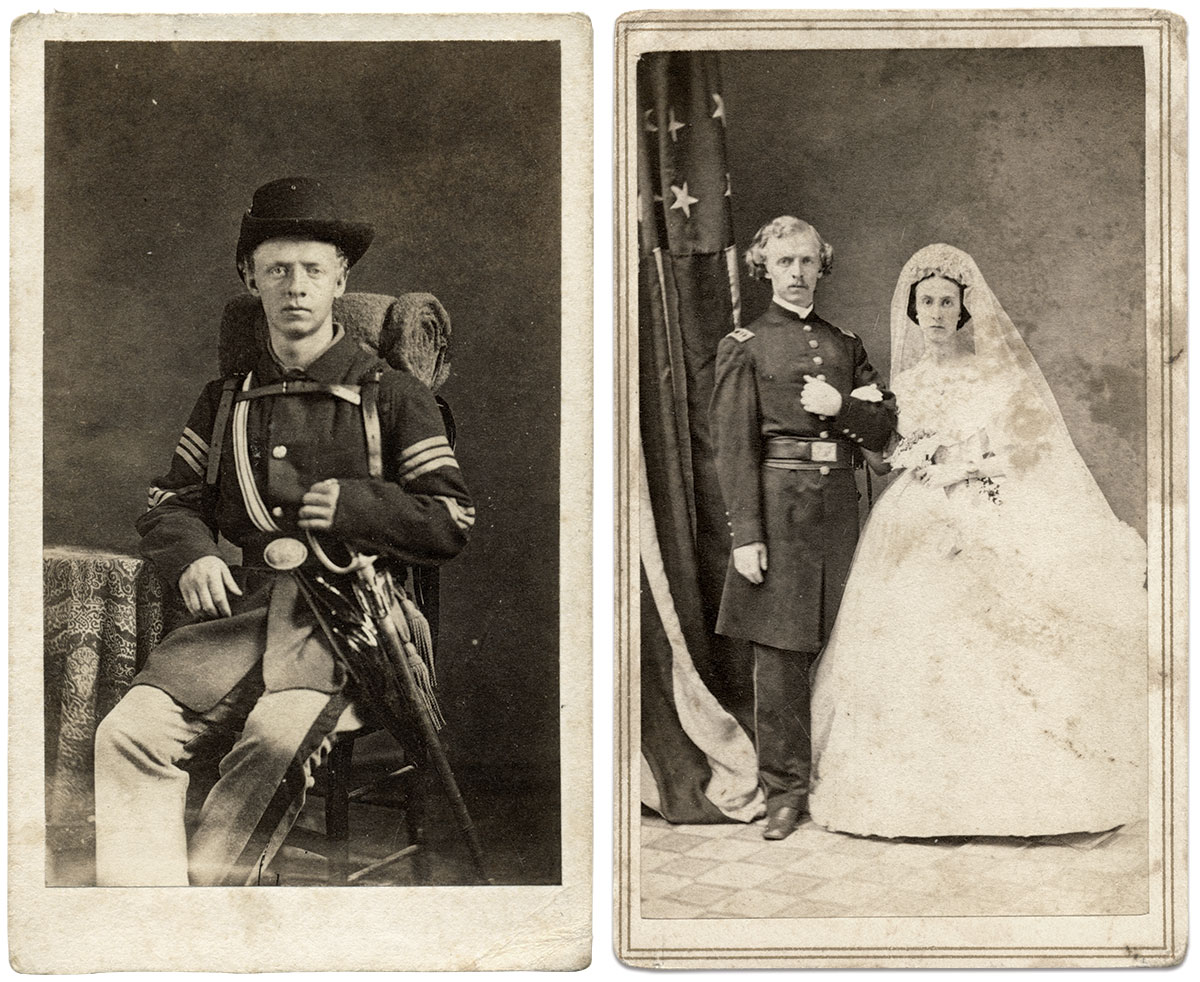
On July 21, 1863, Capt. William Pope Anderson wed Julia Worthington. She hailed from his hometown of Cincinnati, and he was the nephew of Maj. Robert Anderson of Fort Sumter fame. He began his war service in Company A of the 6th Ohio Infantry and served for a time as the regiment’s sergeant major (top right). Slightly wounded at the Battle of Shiloh in April 1862, he left the regiment later that year to become an assistant adjutant general. He went on to serve generals William R. Terrill, Ambrose E. Burnside and Horatio G. Wright. At the war’s end, he reunited with Julia, and started a family that grew to include eight children, five of which survived into adulthood. Anderson died in 1897. Julia lived until 1925.
The Protector
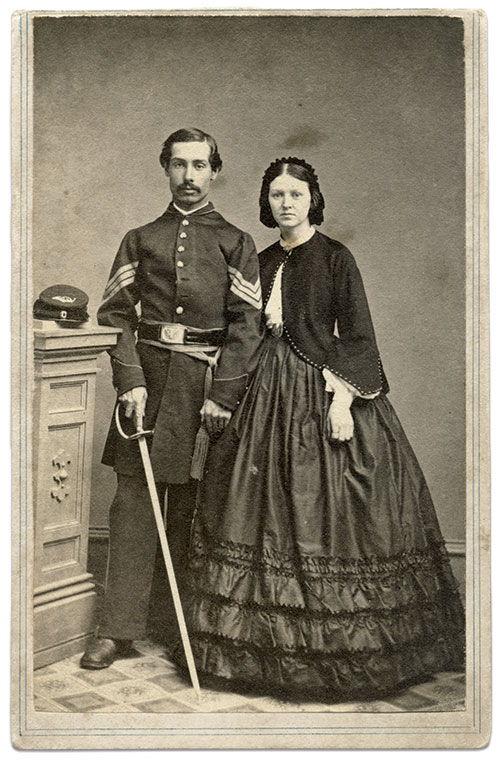
The vision of this infantry sergeant, who guards his lady with drawn sword and a calm, determined gaze, suggests the defense of home and hearth.
Mixed Signals

This federal infantryman tenderly wraps an arm and one hand around that of his wife, and with the other, strikes a possible awkward imitation of a well-known pose by Napoleon. Citizen volunteers on both sides of the conflict would have been familiar with engravings of the Frenchman and other military legends.
Heeding the Call
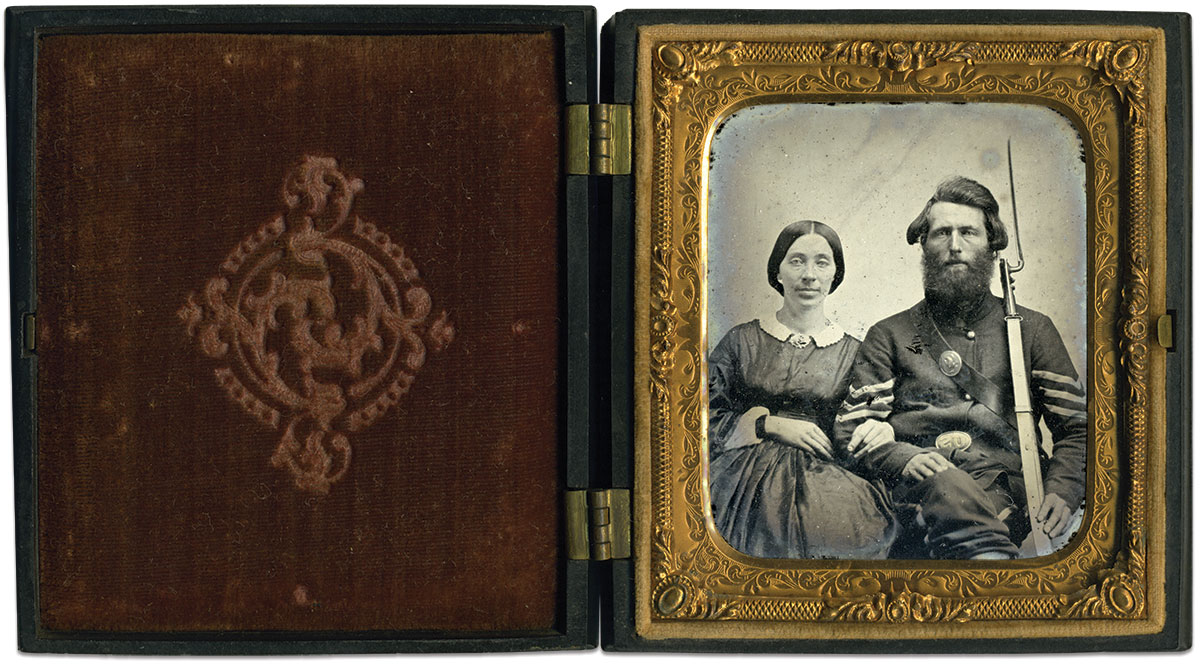
This federal sergeant appears to be a bit beyond the 26-year-old average age of a Northern soldier. The same goes for the woman at his side. Yet, both have embraced the need to separate—perhaps forever—to heed the call to arms and put down the rebellion.
Caution and Support
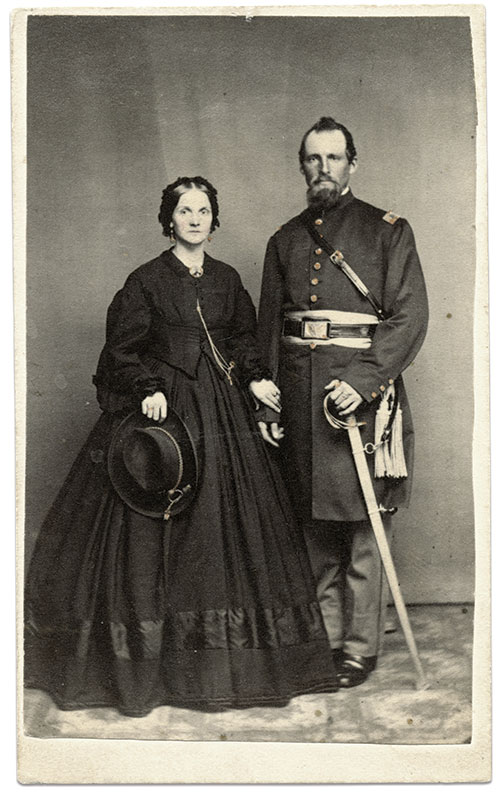
The wife of this Union captain, above, places a hand on her husband’s forearm in a manner indicative of caution. In a show of support, she holds her husband’s hat in her other hand. Pinned to her blouse is a portrait, perhaps of her captain in civilian dress.
Shared Note

A sheet of paper held between the hands of a Union captain and his daughter provides the focal point of this family portrait. Mother and wife stands behind her husband.
Next Move

A cavalry lieutenant and friends are all smiles. The nature of his relationship to the woman next to him is not known. She appears engaged in a game of solitaire, perhaps a suggestion of her marital status—and his next play.
Tall and Short

Despite their differences in height, the towering second lieutenant successfully offers his arm to the little lady in a feathered bonnet and gauntlets.
Adoration
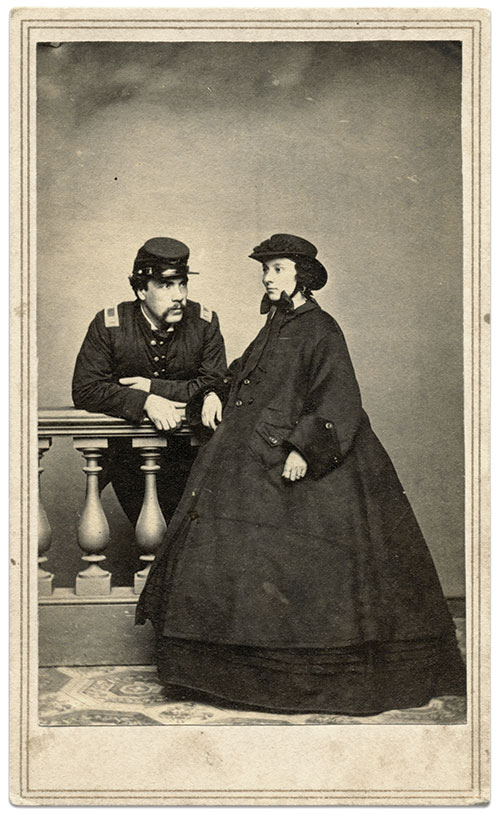
Though relatively short in stature, the woman at the center of this portrait appears larger than life. She may be heavy with child or overdressed in bulky winter clothes. The adoring look of the captain leaning over the balustrade supports the former possibility.
Delicate touch

Attired in an off-the-shoulder dress, this young lady is very likely the soldier’s daughter. The delicate hand touching her father’s coat sleeve, and they way she leans into his side, suggests she would prefer that he did not go off to war.
Double portrait

This view of a Tennessee first lieutenant and a woman, probably his wife, contains a second portrait easily missed, an oval photograph in the center of the cloth belt wrapped around her waist. Though barely visible, the individual pictured may be the lieutenant.
War and Peace

The uniform worn by this first or orderly sergeant, and the spray of flowers held by the woman presumed to be his wife, echoes a theme of war and peace. The backdrop of a classic Greek architecture enhances the metaphor.
Supportive sibling?

This carte de visite does not have inscriptions of the names of the drummer or the woman, who rests a supportive hand on his shoulder. But the lettering on his drum identifies him as George Mygatt McFarlane of the 11th Illinois Infantry. An Ohio-born farmer who settled in Illinois prior to the war, he enlisted as a musician in September 1861. He advanced to principal musician in the summer of 1864, when he posed for this portrait wearing the stripes that indicate his rank. A search of genealogical records indicates that the woman by his side is not his wife; he did not marry until later in life. The woman may be one of his younger sisters, Catherine or Eleanor. McFarlane lived until 1913.
Nursed to health?
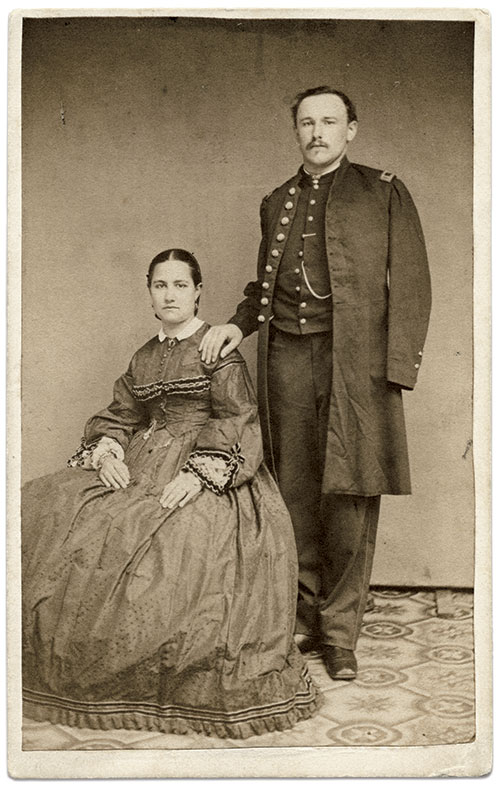
The empty sleeve and fleshy features of this first lieutenant indicates that he has made a full recovery after his amputation. It is a safe bet that the woman seated by his side is the dedicated wife who restored his health.
Telling Faces
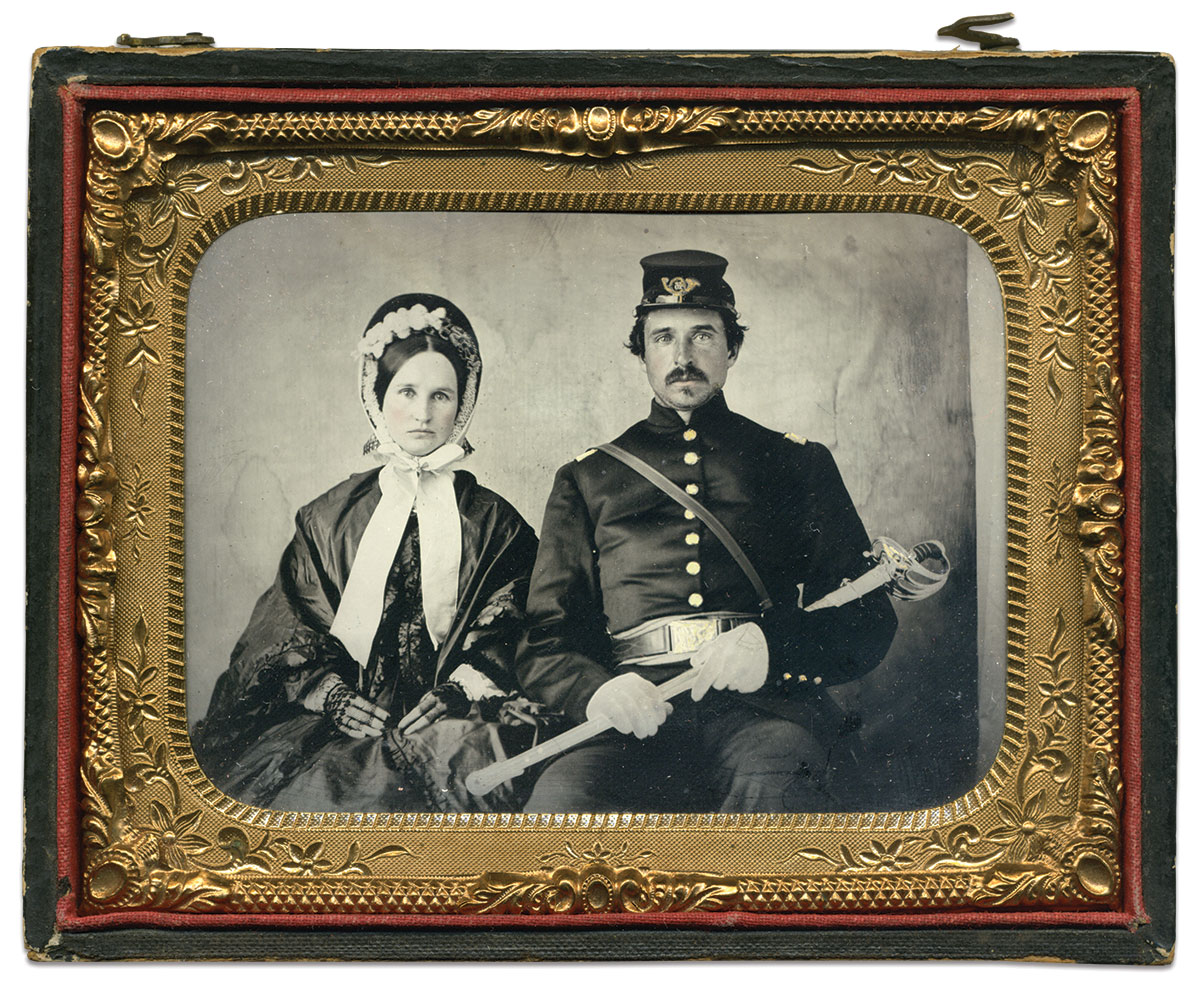
Sadness and uncertainty radiate from the faces of this Union officer and the woman by his side. The fates that awaited him on some faraway battlefield and her on the home front is lost with their names in time. The insignia on his cap, 45th Infantry, offers a clue to his identity.
Emotionally distant or plain uncomfortable?

The first impression of this portrait hints that the man and woman are individuals rather than a couple. He sits with his hands folded in his lap, while she stares blankly ahead in a fur shawl and elaborate bonnet. Another possibility suggests that they may indeed be a couple unaccustomed to sitting before the camera. Photography was still a relatively new phenomenon. Many Americans had yet to learn how to appear comfortable and natural in front of the lens.
Stealing the show
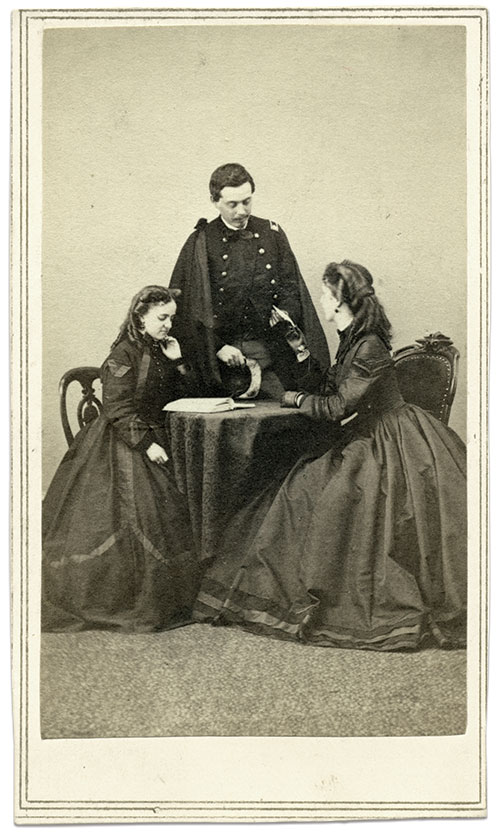
The main focus of this portrait, left, is the exchange of a note between the young lady, turned away from the camera, and a Union staff officer. Yet, the woman absorbed in a book steals the scene. Is she a quiet confidante of one of the parties, or perhaps the matchmaker who worked behind the scenes to make magic happen? On the other hand, she may be the coy author of the love letter handed to the officer by her friend.
Jerry Saunders makes his break to freedom

During the final months of the Civil War in tobacco-rich Scott County, Ky., prosperous plantation owner Urias Offutt died at age 53. His wife, children and 17 slaves, including Emily Spotts Saunders and her husband, Jeremiah, survived him. Less than a month after his master passed, Jerry, as his friends called him, turned up at Camp Nelson, a bustling Union hub located about 50 miles from the plantation. He enlisted in Company K of the 124th U.S. Colored Infantry, a regiment composed of older men determined unfit for the rigors of camp and campaign, but able to perform lighter duties. Jerry, age unknown, took his place in the ranks and soon advanced to corporal.
His enlistment ended in late 1865, and he returned to Emily. Two years later, they legalized their informal slave marriage. They lived together until the summer of 1882, when Jerry died from pneumonia. Emily and a daughter, Eliza, survived him.
Embracing the future

A Union soldier holds his child and wife in a warm embrace. His dark complexion suggests a man who works outdoors, and who posed for a last portrait before going off to war, or a veteran campaigner on furlough for a temporary reunion at home. His tanned hands create a stark contrast with the light skin tones of the baby and mother.
Lila and Walter
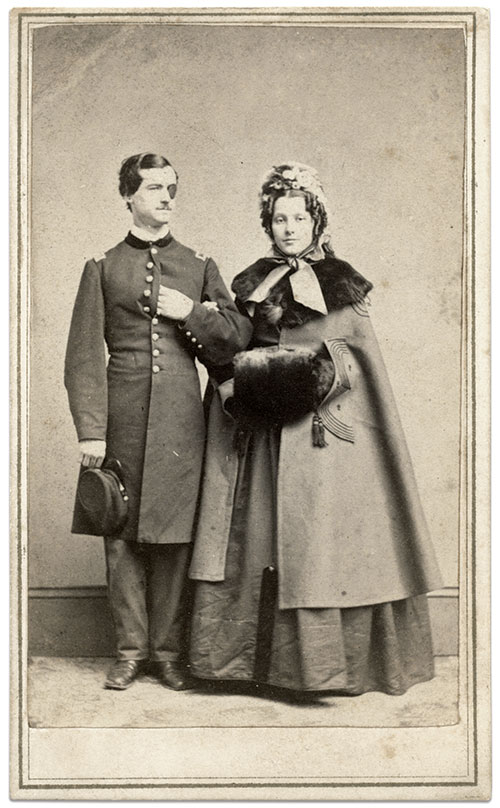
Lila Halleck gazes at the camera with a hint of a smile on her lips, and a dashing husband by her side. He is Walter Franklin Halleck, a Michigander who was sort of a Civil War Zelig. As a private in his home state’s 11th Infantry, he suffered a wound that cost him an eye at the Battle of Stones River, Tenn., and a trip to Libby Prison. After his release and exchange, he joined the Veteran Reserve Corps. He went on to join the regular army when hostilities ended and served in the West. He ended his career as a captain.
Halleck started a family with Lila that grew to include four children. The marriage ended in divorce in 1889 due to an “incompatibility of temperament.” Two years later, he wed Helen T. “Nellie” Fulmer, a woman about 20 years his junior. They had a son and a daughter, both of whom died in early adulthood. Upon his passing in 1915, Nellie received his pension until her death in 1940.
Elizabeth’s Father

Elizabeth Lyman was born just nine days before the bombardment of Fort Sumter. Growing up in Pennsylvania during the war years, she saw little of her father, Jonas Wellman Lyman. He began his war service just a few months after her birth as surgeon of the Keystone State’s 57th Infantry. By the time this portrait was taken, he had gone on to become lieutenant colonel of the 203rd Pennsylvania Infantry. He proudly wears his Kearney Medal, an honor presented to officers who served with the division commanded by Maj. Gen. Philip Kearney, prior to his death at the Battle of Chantilly, Va., in 1862.
Elizabeth could not have known that this would be one of the final times she could rest her hand on her daddy’s uniform coat. On Jan. 15, 1865, he was killed in North Carolina during the Battle of Fort Fisher. Elizabeth, two older brothers and her mother, Louisa, survived him. Little Elizabeth grew up, married, raised her own family and lived into the 20th century.
SPREAD THE WORD: We encourage you to share this story on social media and elsewhere to educate and raise awareness.
SPREAD THE WORD: We encourage you to share this story on social media and elsewhere to educate and raise awareness. If you wish to use any image on this page for another purpose, please request permission.
LEARN MORE about Military Images, America’s only magazine dedicated to showcasing, interpreting and preserving Civil War portrait photography.
VISIT OUR STORE to subscribe, renew a subscription, and more.

